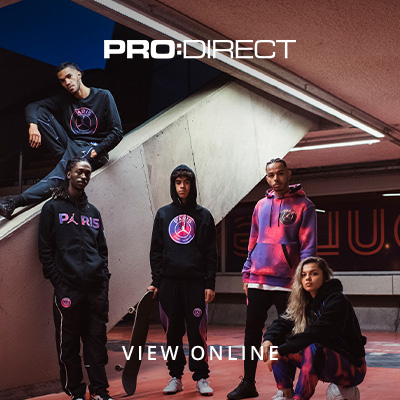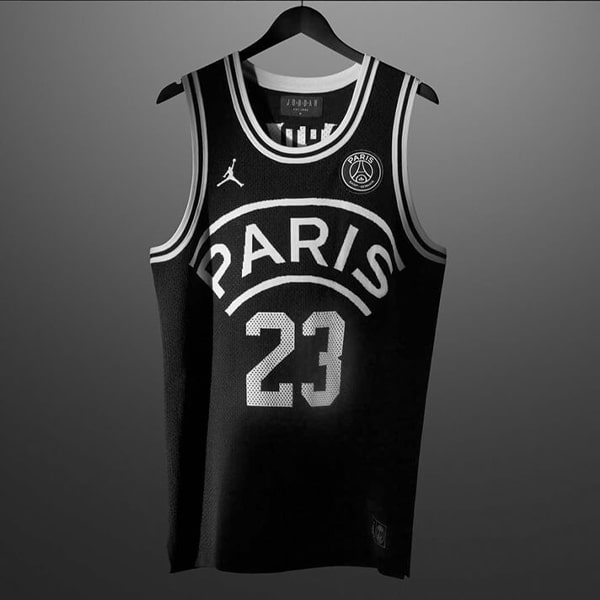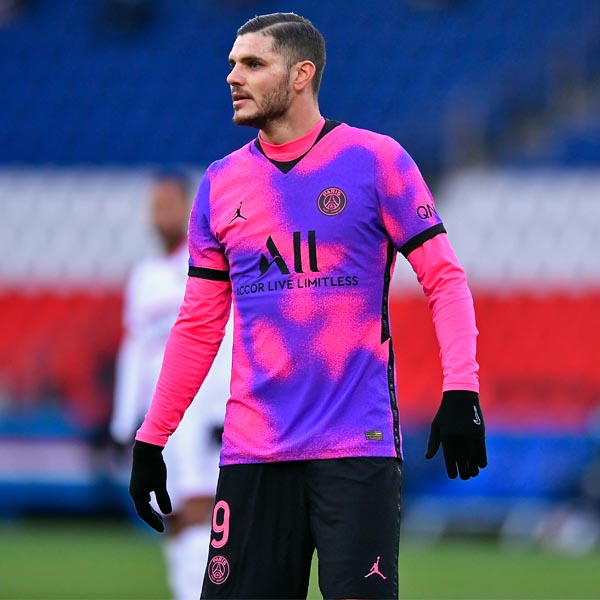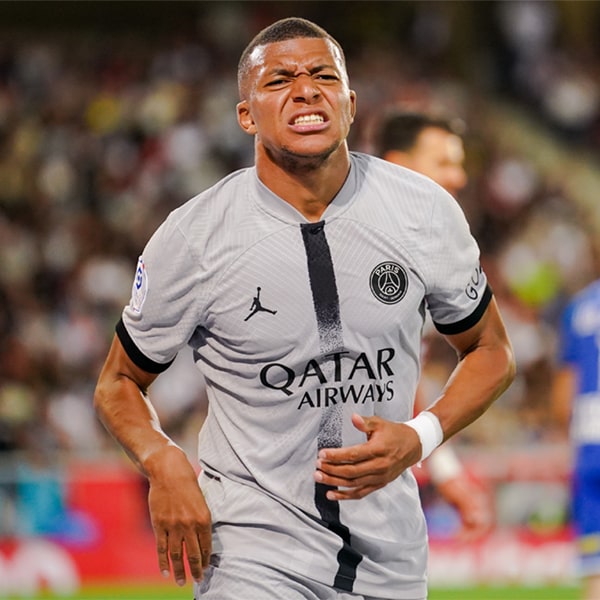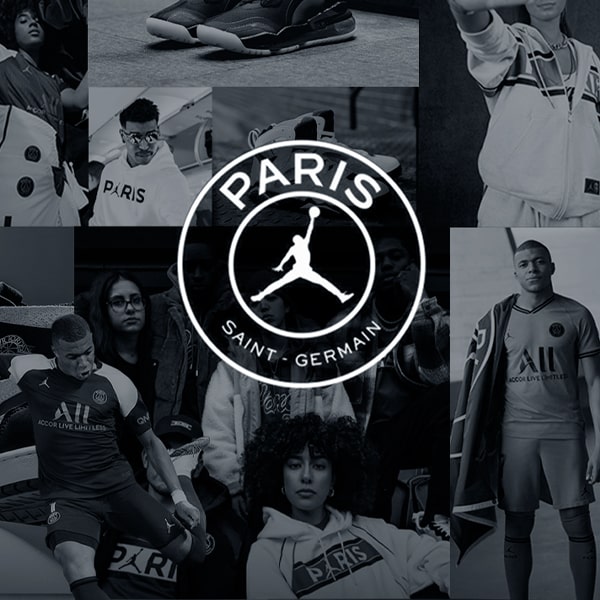Turn the clock back 15 years and the idea of any other sport having an influence on football – the world’s game – was nigh-on unthinkable, let alone a sport that is predominantly played in the USA. But in the intervening period, basketball has not only had an impact on the game, it has been ushered to the very top table, becoming a VIP, and instantly boasting a premium feel.
Football and football culture has undergone some radical changes over the last two decades. But there are arguably no changes as radical as the introduction and influence from other cultures outside of the game, be it fashion, music or other sports, and most notable among these is basketball. The unprecedented collaboration between PSG and Jordan – now ploughing through its third season with the latest release dropping at Pro:Direct Soccer today – has become one of the premium drops on the calendar, elevating in status with every passing campaign. What started as an all-out hype event has fast become a well accepted and expected presentation of pure fire, crossing cultures seamlessly as it brings two separate worlds together.
You can imagine that when the mention of basketball crossing over into football first came up there would’ve been several dismissive sniggers around the boardroom table. Basketball was, after all, predominantly played in the United States, a place where “Soccer’s” influence was still in its infancy. But look a little closer and the similarities between the sports is right there for all to see: these are the two biggest sports in the world, both easily accessible, and boasting a strong crossing across different cultures. Basketball’s – and specifically the NBA’s – influence on American street culture for example, reverberates across generations and countries: from floodlit arena games broadcast for millions, to DIY hoops and scuffed school gyms. It’s the game that’s open to all, and is played as such. All you need is a ball and something that’ll pass as a hoop. Now switch that hoop out for a pair of jumpers for goal posts, and the easily accessible nature of both sports becomes instantly recognisable.
While basketball as a culture is something that has gestated over a far greater time, football culture has evolved to become what it is today. Football was an exclusive club for many years, but with the turn of the millennium came a new generation, and with it the seeds of change. David Beckham was one of the first true global superstars of the game, and when he opted to sign for Real Madrid in what was one of the biggest transfers of all-time from a hype perspective, his chosen number, seven, was already in use by Raul, and so he had to take on a new number. He chose the number of someone that he looked up to; a role model that he always aimed to emulate in a performance sense – the number 23, that of one Michael Jordan. It was the first time that football, in any sense, had openly acknowledged basketball, taking that acknowledgment further to an outright expression of admiration. The world took note.

Born from that moment, the mutual appreciation between players of both sports is now clear for all to see today, and you only have to look at the famous footballing faces that littered the crowd in London when the NBA rolled into town back in 2018, or equally when the Bucks played the Hornets in Paris in 2020 to see the high regard in which the sport is held by Europe's elite.
PSG have taken influence from their home city, becoming trailblazers of the football fashion movement over recent years, with style both on and off the pitch a vital part of the club’s identity"
Flash forward a decade from Beckham's Galacticos switch, and another footballing superstar who was only too happy to openly express his admiration for Jordan emerged on the scene. Soon after they met and sparked a friendship in 2015, a huge precedent was set when Neymar became the first athlete across all sports to feature the Jumpman on his own performance product with the release of the NJR x Jordan Hypervenom II. The design took inspiration from the Jordan V, a personal favourite of Neymar’s. Splashed with dual signature styles, the release caught the attention as one of the first cross-sport collaborations – basketball had officially made its first official appearance in football.
This intersection of cultures came at a time when Neymar was still a Barcelona player, but he soon made the decision to leave the La Liga club to forge his own identity away from the shadow of Lionel Messi. And so, in 2017 he found himself at Paris Saint-Germain.
Paris is well known as one of the fashion capitals of the world, with style and culture at the heart of what the city represents. PSG have taken influence from their home city, becoming trailblazers of the football fashion movement over recent years, with style both on and off the pitch a vital part of the club’s identity. In 2013, a new club crest was joined by the statement signing of that man Beckham again, as he lined up alongside the likes of Ibrahimovic, Verratti and Cavani for what was undoubtedly the start of the PSG as we know them today. Despite a history of sleek looks from their past, from this moment on the Ligue 1 side, with Nike in support, marked themselves out as not just a club, but as style icons. But the best was yet to come.
PSG were implementing a new strategy that was at the forefront of the shift in football culture through the 2010s, establishing themselves as the leading streetwear club in the world, collaborating with Koché for a Spring 2018 collection, and releasing a capsule with Commune de Paris, to name just two lifestyle-centred projects. Where some traditionalist eyebrows may have been raised at some of these exploits, they were establishing themselves as the original trailblazers, and this new approach saw them focus hard on their fashionable image with celebrity connections and lifestyle branding to carry the brand image onto a global scene. All it was lacking was a big, bold statement to truly mark this new age.

With Neymar and his existing connections to the basketball world on board, Nike being only too willing to step aside for one of its subsidiary brands, and PSG in a prime position to fully leverage the move, Jordan made their next foray into football.
Initially, the rumour of a crossover with PSG was nothing more than that; a rumour gaining momentum with every whispered word. Just hours after Paris Saint-Germain sealed a domestic treble by lifting the Coupe de France in 2018, images emerged of an Air Jordan 5 Retro sneaker that paid tribute to the Parisian power houses of footballing style, lending further fuel to the speculative fire. The hype train was gathering pace, and as time passed it appeared that it was not only accepting passengers from the sporting world. Rumour shifted into full on tease mode when confirmation of the collaboration was pretty much signed, sealed and delivered with Justin Timberlake and Travis Scott stepping out for their respective shows in France wearing co-branded PSG x Jordan items.
What had yet to be confirmed at this point however, was whether this drop would sit purely in lifestyle circles, as with previous club collaborations. But all the speculation was put to rest when PSG became the first elite club to have kits produced by a non-footballing brand, with not one, but two special edition match kits produced by Jordan, which the club wore exclusively in the Champions League. And to see how well received the whole collaboration was, you only have to look at the demand for the product, exemplified by how quickly the collection sold out, coupled with the longevity of the partnership – it has recently been reported that PSG have activated a year-long extension to their existing €200million three-year deal with Jordan, taking the highly successful partnership into the 2021/2022 season
From its inception it became instantly clear that PSG x Jordan was more than just a PR stunt; it represented the dawn of a new age for both football and basketball culture, and its success opened up a market to clubs using more streetwear/fashion labels as kit producers"
The collaboration and everything that came with it was widely lauded. NBA All-Star and Jordan Brand Family Member Jimmy Butler was quoted as saying “I can’t wait to see PSG and my guy Neymar rocking the Jumpman. Every time I visit Paris, I feel like there’s more energy for Jordan in the city. Putting the Jumpman on PSG is going to take it to another level.” The appetite for this kind of crossover was clear, and fans of both sports along with those who had a purely lifestyle-vested interest, were hooked.
From its inception it became instantly clear that PSG x Jordan was more than just a PR stunt; it represented the dawn of a new age for both football and basketball culture, and its success opened up a market to clubs using more streetwear/fashion labels as kit producers. It introduced the world of football to the concept of collaborations, and without it there certainly would’ve been no Juventus x Palace, and you could argue whether Nike would’ve pursued its Air Max-inspired Champions League shirts. It dived head first into a space that had never previously been explored, offering up the sight of NBA stars arriving for games in the latest football shirts, something that was kicked off by Zion Williamson stepping out in the PSG x Jordan Spring 2020 Tracksuit.
Where it could’ve been dismissed as a move to increase the club’s popularity in a new market, instead it was embraced. Rather than being denied entry at the door, basketball was instead marched straight to the front and taken directly to the VIP section. The collaboration was premium, and it not only left its mark on football culture, it fully shifted its trajectory into entirely new spheres.

Shop the PSG x Jordan 20/21 Fourth Shirt and supporting collection from 5 February at prodirectsoccer.com












